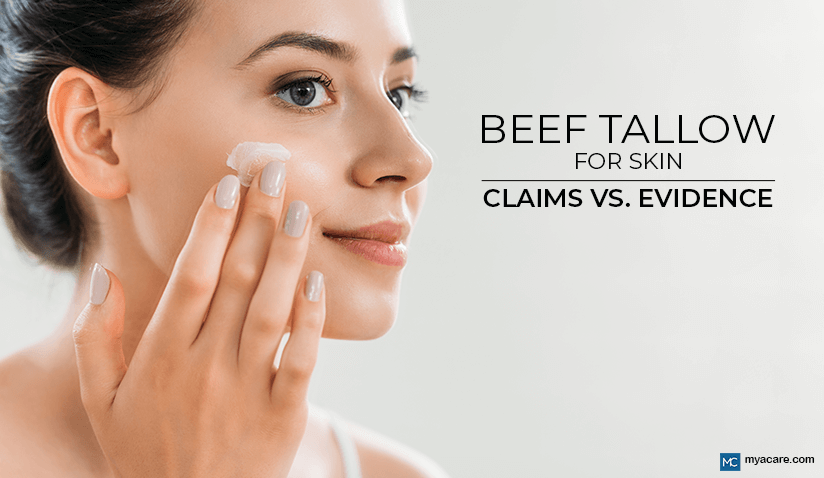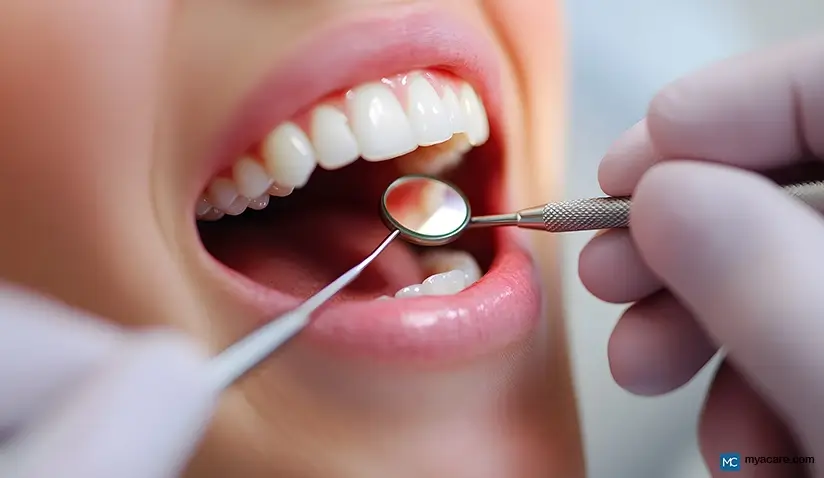Beef Tallow for Skin: Evidence, Safety, and Uses

A forgotten dinner table feature recently made a surprising comeback, this time in the bathroom cabinet. Beef tallow has been touted as a “miracle ingredient” by the DIY skincare community and has been trending widely on social media platforms. It is hailed by some as a natural solution for aging, sensitive, or dry skin.
As a result, influencers and natural beauty enthusiasts alike are whipping up their own tallow-based skin balms and moisturizers, claiming that the benefits of beef tallow rival those of high-end skincare brands. However, is there sufficient scientific evidence to support these claims?
This article explores the rising interest in beef tallow as a skincare ingredient, delving into research that addresses the question: Is beef tallow good for the skin? This review also evaluates both the safety and efficacy of the product and includes insights from dermatologists regarding the topical application of rendered animal fat.
What is Beef Tallow?
Beef tallow is a form of rendered fat derived from the suet (hard beef fat). It is created by slowly heating suet to melt and separate the pure fat from any remaining water, protein, or impurities. When it cools, tallow solidifies into a creamy, shelf-stable substance with a texture similar to soft butter or balm.
Historical Use in Skincare and Soap-Making
Tallow-based skincare is not a new invention. Beef tallow was a common ingredient in traditional remedies and handmade soaps centuries before the advent of modern skincare products.
People used tallow-based salves to soothe dry or cracked skin, especially in harsh climates. It was prized for its moisturizing properties and used by pioneers, farmers, and healers as a natural, accessible solution for skin protection and healing.
Beef tallow, in soap, was valued for its ability to create a firm, long-lasting bar with a rich lather. Many heritage and artisan soap-makers continue to use tallow today for its unique benefits.
Beef Tallow Composition
Beef tallow is not just fat. It is bioavailable (easily absorbed) and packed with nutrients that can benefit the skin, such as saturated fats, vitamins A, D, E, and K, and conjugated linoleic acid (CLA).
What Are the Claimed Beef Tallow Benefits for Skin?
There are reasons why beef tallow is gaining attention as a natural, nutrient-dense alternative to conventional skincare products. Supporters say it delivers a wide range of benefits for skin health. Mostly due to its unique composition and compatibility with the skin's natural oils. Here are some of the most commonly claimed skin benefits of beef tallow:
Moisturizing and Skin Barrier Protection
Tallow is rich in saturated fats, and its structure is similar to human sebum (the natural oil produced by our skin). Beef tallow moisturizer benefits include:
- Deep hydration (does not clog pores).
- Repair and strengthening of the skin’s protective barrier.
- Ability to lock in moisture and reduce dryness, flakiness, and irritation.
Rich in Fat-soluble Vitamins
Beef tallow naturally contains several fat-soluble vitamins that are essential for skin health. For example, vitamin A supports skin cell turnover and regeneration, while vitamin D helps modulate inflammation and improve skin barrier function.
Vitamin E, a potent antioxidant, shields the skin from oxidative stress and promotes healing, whereas vitamin K supports skin elasticity and reduces the appearance of dark circles or redness.
Antioxidant and Anti-inflammatory Properties
The purported benefits of beef tallow on the skin extend beyond moisturizing and vitamins. Conjugated Linoleic Acid (CLA), a component of beef tallow, may help soothe inflamed or irritated skin and reduce redness or swelling associated with conditions like eczema or acne. The fatty acid also protects the skin from free radical-induced damage caused by pollution or UV exposure.
These properties make tallow-based products appealing for those looking to care for sensitive skin without synthetic ingredients.
Who Might Benefit From Using Beef Tallow?
Pure beef tallow for skin is not suitable for everyone. However, it may be helpful for certain people. For example, individuals with dry, flaky, or sensitive skin or those who suffer from eczema, psoriasis, or rosacea and are seeking gentle, non-irritating alternatives.
Additionally, people who prefer natural and minimalist skincare routines and those sensitive to additives, fragrances, or preservatives in commercial products could consider beef tallow for skin care.
What Are the Potential Risks and Concerns?
What does tallow do for your skin? This is a common question. While beef tallow has been praised for its natural richness and skin compatibility, it is not without drawbacks. Here are some important considerations:
Comedogenic Potential and the Greasy Factor
Beef tallow is highly emollient and occlusive. It forms a protective layer on the skin to lock in moisture. However, this same quality can make it feel heavy or greasy, especially for individuals with oily or acne-prone skin.
On a scale of 5, beef tallow’s comedogenic rating is 2 or 3. So, while tallow is often well-tolerated by dry or sensitive skin types, its thick texture could potentially clog pores in some users.
Allergy or Sensitivity
Allergic reactions or sensitivity can occur, but such skin-related side effects are considered rare. However, some people are more likely to experience them, such as individuals with beef allergies or sensitivities to animal fats and a history of contact dermatitis or reactive skin. Symptoms of beef tallow allergy might include redness, itching, or rash.
Contamination Risk
Homemade or poorly processed beef tallow can carry a risk of contamination if not rendered, stored, or handled properly. These risks include:
- Bacterial growth due to leftover moisture.
- Rancidity (if stored in warm or humid environments).
- Presence of impurities (e.g., residual proteins or connective tissue).
To minimize these risks, it is essential to use high-quality, purified, organic grass-fed beef tallow from reputable sources or follow strict guidelines when making it at home.
Ethical and Vegan Concerns
Beef tallow is not vegan. Therefore, it raises ethical questions for some consumers. These include:
- Animal welfare and industrial farming practices.
- Environmental impact of livestock production.
- Incompatibility with plant-based or cruelty-free lifestyles.
Who Should Avoid Beef Tallow?
Beef tallow may not be appropriate for everyone. It is not recommended for:
- Vegans and vegetarians seeking plant-based products.
- People with beef allergies or sensitivities.
- Those with very oily or acne-prone skin, unless advised otherwise by a dermatologist.
- Anyone using prescription acne treatments (like isotretinoin).
Can Beef Tallow Make Eczema Worse?
The effectiveness of beef tallow for eczema remains inconclusive. Many people with eczema report relief from tallow-based balms due to their barrier-protective and anti-inflammatory properties. However, in some cases, beef tallow can also:
- Trap irritants against the skin if not applied to clean, dry skin.
- Cause a reaction in those with underlying sensitivities to animal products.
- Be too occlusive for individuals prone to folliculitis or skin infections.
From a Dermatologist’s Viewpoint
Dermatologists have mixed opinions about beef tallow as a skincare ingredient. This is largely due to the lack of clinical research supporting its topical use. While anecdotal success stories are commonly seen on social channels, there are currently no FDA-approved skincare products that use beef tallow as an active ingredient. This means that its safety and efficacy have not been rigorously studied in a medical context.
Mixed Views on Animal Fat in Skincare
Some dermatologists are intrigued by tallow’s natural composition. However, many remain cautious due to concerns over the stability and purity of homemade formulations, the potential for pore-clogging in acne-prone individuals, and the risk of irritation or infection if applied to broken or compromised skin.
Does Beef Tallow Help with Acne?
Currently, there is no consensus on the efficacy of beef tallow for acne. Supporters claim beef tallow helps reduce acne by calming inflammation and restoring the skin barrier. Others warn that its heavy, occlusive nature can worsen breakouts, particularly in people with oily or congested skin.
These differing views stem from the fact that acne has multiple causes, including hormones, bacteria, and excess sebum. What helps one person might aggravate another’s condition.
Therefore, it is advisable to remain cautious until clinical studies provide more definitive insights.
Is Beef Tallow Better Than Retinol?
Beef tallow may moisturize and nourish the skin. However, it is not a substitute for retinol. Retinol is a well-studied, dermatologist-recommended ingredient known for increasing cell turnover, reducing wrinkles, and treating acne.
Tallow may offer supportive benefits for the skin barrier, but it lacks the proven anti-aging and acne-fighting properties of retinoids.
What are Safer Alternatives to Beef Tallow?
For those seeking natural or board-certified dermatologist-approved options without the risks associated with animal fats, there are several plant-based and clinically validated alternatives, such as:
Plant-based emollients:
- Shea body butter (deeply moisturizing and rich in vitamins).
- Jojoba oil (mimics natural sebum, non-comedogenic).
- Squalane (lightweight, non-greasy, and antioxidant-rich).
Dermatologist-recommended moisturizers:
- Ceramides (restore the skin barrier and preserve moisture).
- Hyaluronic acid (hydrates and plumps the skin without blocking pores).
Considerations for Incorporating Beef Tallow Into Your Skincare Routine
If you are curious about using beef tallow as a natural skincare product, it is important to approach it thoughtfully. Here are some key considerations to keep in mind:
- Patch test first. Apply a small amount to a discreet area (like the inside of your wrist or behind your ear) and monitor for any redness, itching, or irritation.
- If you have known allergies to beef or animal fats or a history of sensitive skin reactions, avoid tallow altogether or consult a dermatologist.
- Choose grass-fed organic beef tallow that has been properly rendered and filtered to reduce the risk of contamination or irritation from impurities.
Beef tallow can be incorporated in several simple ways:
- As a standalone balm or moisturizer
Apply a small amount to clean, damp skin. A little can go a long way due to its richness and occlusive nature.
- As a natural makeup remover
Warm a small amount between your fingers and massage gently into the skin to dissolve makeup, then remove with a warm, damp cloth.
- As a night treatment
Some users prefer applying it at night for intensive hydration, particularly on dry patches or areas prone to flaking.
Blending With Essential Oils or Herbal Infusions
Many DIY enthusiasts customize their beef tallow balms with essential oils (e.g., lavender, frankincense, or tea tree) or herbal infusions (calendula or chamomile) to enhance their scent and therapeutic properties.
This can be beneficial. However, make sure all added ingredients are skin-safe and non-irritating, and avoid excessive amounts of essential oils. They are highly concentrated and can cause reactions if overused.
The Bottom Line
Beef tallow has re-emerged as a natural skincare ingredient. However, it is worth noting that the current trend is fueled by social media and the desire for simple, nourishing ingredients. While its rich composition of fats and vitamins may offer moisturizing and skin-barrier benefits, caution is advised, primarily due to comedogenic risks and potential allergies, but also the lack of regulatory oversight and scientific validation.
To search for the best health providers for dermatology in Croatia, Germany, India, Malaysia, Singapore, Slovakia, Spain, Thailand, Turkey, the UAE, the UK, and the US, please use our free search engine.
To search for the best healthcare providers worldwide, please use the Mya Care search engine.

Dr. Rosmy Barrios is an aesthetic medicine specialist with international work experience. She earned her physician diploma at the Universidad Del Norte’s School of Medicine in Barranquilla, Colombia, and her specialty at John F. Kennedy University in Buenos Aires, Argentina. Dr. Barrios is a member of the Pan-American Aesthetic Medicine Association (PASAM) and the Union Internationale de Médecine Esthétique (UIME). She is an expert health writer with keen interests in aesthetic medicine, regenerative aesthetics, anti-aging, fitness, and nutrition. Currently, Dr. Barrios heads the Regenerative Aesthetics department at a renowned Internal Medicine clinic based in Belgrade, Serbia.
References:
Featured Blogs



